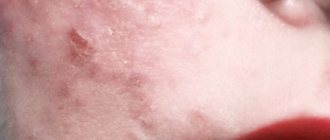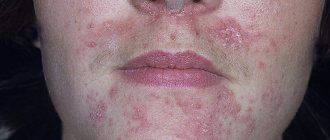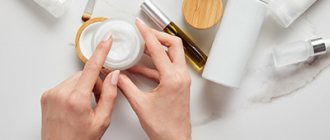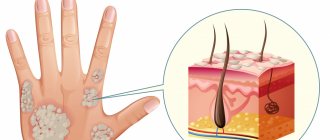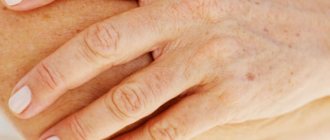August 16, 2021
Peeling on the hands is a signal that the skin is not hydrated enough. In diagnostics, this sign is called “xerosis.” The causes of dry and flaky hand skin are not always pathological. Often this only means that you need to change your household habits. If the discomfort does not go away for a long time, the symptoms increase, you need to contact a dermatologist for an examination.
Causes
The cause of eczema is the body’s reaction to a variety of factors: chemical, infectious, medicinal, physical.
This reaction can be genetically determined (up to 60% if both parents have eczema) and consists of a complex of inadequate reactions of the body’s immune, nervous and endocrine systems to antigens. Why hands? Our hands come into contact with a huge number of different substances and environments: microbes and fungi, various detergents and cleaners, antiseptics (even in soap), temperature effects, prolonged exposure to water, professional contact with various aggressive chemicals. It is not surprising that at some point the body can malfunction and react violently to a seemingly ordinary stimulus.
Treatment of severe peeling hands
Common skin pathologies on the hands are treated with hormonal creams and ointments. The treatment regimen may include vitamins and antibiotics.
During the examination, the dermatologist will assess the condition of the skin, determine the cause and recommend additional measures that will alleviate the condition:
- take long, hot baths less often;
- moisturize the skin of your hands with oils;
- avoid soaps with an aggressive pH;
- use towels made of natural fabric.
General strengthening procedures promote rapid recovery.
It is important to normalize the diet and the diet itself, increase the body’s protective functions and improve metabolism. This is facilitated by physical exercise, acupuncture, massages, hirudotherapy, the effectiveness of which has been proven for skin diseases. August 16, 2021
Author of the article: dermatologist Mak Vladimir Fedorovich
Forecast
The prognosis for eczema is most often favorable.
If you start proper treatment in time, you can curb the disease and get rid of its consequences. With adequate therapy, itching and elements of the old rash disappear, a new rash does not appear. Eczema is a chronic disease, so it is worth adhering to preventive measures and maintaining a state of remission. However, the timing of relapse is still unpredictable. Doctors give the most favorable prognosis for acute eczema. Recovery may be worse if eczema develops in young children, the elderly, or people whose bodies are weakened by infection. To enhance drug treatment, a hypoallergenic diet, physical activity, walking and hardening will help.
Associated symptoms
Often, xerosis is a temporary phenomenon that is disturbing during the cold season. The intensity of the manifestation depends on the general condition of the body, age, and the presence of pathological causes. Additional symptoms may indicate that the condition is caused by a disease:
- redness that spreads to adjacent areas of the skin;
- feeling of tightness, discomfort;
- microcracks;
- wrinkled, dehydrated skin;
- increasing itching;
- the appearance of wounds and ulcers that are difficult to heal;
- roughening of the skin, thickening of the top layer.
Depending on the pathogenesis of the disease, the dermatologist will prescribe a comprehensive treatment regimen with procedures and medications.
Treatment of the pathological condition
The first and surest step to getting rid of an uncomfortable condition is to see a doctor. It is optimal to visit a therapist who, if necessary, will refer you to a dermatologist, endocrinologist or gastroenterologist. The exact cause of the cracks will become known after a series of tests (blood tests, scraping of epidermal cells from the affected area, etc.). Based on the diagnostic results, the doctor decides on a plan on how to treat the cracks. As a rule, local drugs with restorative properties, vitamin and immunostimulating complexes are prescribed. For fungal infections, antifungal ointments and creams, as well as antibiotics, are used. Endocrine disorders are eliminated through hormonal therapy.
Soda and salt baths and compresses based on pharmaceutical herbs (chamomile, calendula) are indicated as additional therapeutic measures. Such procedures can be carried out at home. In addition, it is recommended to regularly lubricate the skin with emollient creams and Vaseline.
The main causes of cracks in hands
The cause of pathological changes may be connective tissue disease, diabetes, iron deficiency anemia, and the like. Of the skin diseases that cause cracking of the epidermis, the most attention should be paid to eczema and psoriasis. With eczema, focal redness and peeling of the epidermis appear, which are accompanied by severe itching. With psoriasis, certain areas of the skin become thick and pink, and silvery scales are visible on the surface.
Cracking of the epidermis between the fingers can be caused by fungal infections. Often these diseases worry patients with excessive sweating of their hands. In this case, the epidermis peels off and itching is felt. If the fungus has infected the nails, their shade changes, a white mass accumulates under the nail plates, and the nail peels off from the bed.
Cracks on the fingers of the upper extremities can appear due to contact dermatitis associated with allergies to household chemicals. In childhood, atopic dermatitis with similar symptoms can occur.
Types and forms of the disease
Treatment for finger eczema depends on what stage of development the disease is at. It is characterized by a wave-like course: exacerbations are replaced by periods of remission. Hands are most often affected by dry eczema, in which papules with exudative fluid do not form on the skin. The disease can occur in one of the following ways:
- Ostrom. Symptoms appear suddenly, swelling quickly develops, and redness forms. The disease develops within a couple of days, and sometimes even in a matter of hours.
- Subacute. Eczema does not develop as rapidly and is less pronounced than in the acute form. The disease itself lasts for several months and only then subsides for an indefinite period of time.
- Chronic. The most common form of eczema, in which relapses and periods of improvement regularly follow each other.
Nutrition for vitamin deficiency of the hands
Proper, balanced nutrition is the key to the prevention and rapid treatment of vitamin deficiency. Since this form of the disease, such as vitamin deficiency of the hands, speaks primarily of a lack of vitamins of groups A, B and E in the body, doctors recommend consuming foods rich in these particular vitamins.
The diet must include:
- meat, fish, seafood, eggs;
- legumes, grains, fermented milk products (cottage cheese, cheese, fermented baked milk, yogurt, sour cream);
- fresh fruits and vegetables, nuts.
It is better to replace refined drinks with a high sugar content with juices, fruit drinks and compotes, preferably homemade, without preservatives.
Taking a multivitamin complex
Taking multivitamin complexes can provide quick help in the fight against vitamin deficiency. Today the market offers a huge number of high quality and effective products. These complexes are pure synthetic chemical compounds containing the necessary balanced set of vitamins and microelements. A specialist should recommend such drugs to each individual individually.
Diseases that are accompanied by dry skin
If dry skin is caused by pathologies inside the body, you should consult a doctor.
Creams, ointments and baths will only provide a temporary effect. While the skin will only be helped by eliminating the pathology that caused moisture deficiency. The following can lead to dehydration of the hands: allergies, fungus, iron deficiency anemia, gastrointestinal pathologies, skin diseases, weakened immunity, diabetes mellitus and other reasons. Allergies
An allergic reaction can be caused by wearing inappropriate jewelry on your hands or eating foods. Only a dermatologist can help determine the type of allergen. You can get rid of dry skin caused by allergens by completely eliminating contact with them.
Fungal infection
Dry hand skin can be a consequence of the pathological effects of fungi.
Often the feet and nail plates are simultaneously affected. If you suspect a fungus of any nature, it is recommended to consult a dermatologist or mycologist. The doctor will help determine the type of disease and tell you how to get rid of it. Iron deficiency anemia
Dry hand skin is just one of the manifestations of this disease, however, it is not the most pleasant one.
Timely consultation with a doctor (hematologist or therapist) and a balanced diet can completely get rid of anemia and its manifestations. Pathologies of the gastrointestinal tract
If the functions of any of the gastrointestinal organs are disrupted, the process of food absorption is disrupted.
Lack of vitamins and microelements adversely affects the skin. This becomes the main cause of dry epidermis. Skin diseases of various types
Psoriasis, dermatitis, keratosis, and eczema can lead to disruption of the hydrolipid balance. They not only cause dry hands, but also manifest as cracks, itching and redness in many areas of the skin. In this case, careful medical monitoring of the skin of the hands and other affected areas is required. Proper use of medications will help get rid of pathologies and their unpleasant manifestations.
Diabetes mellitus
With the development of diabetic neuropathy, sweating is impaired, which provokes the appearance of small cracks in the skin, dryness and a feeling of tightness.
Medicines prescribed by a doctor will help reduce the unpleasant manifestations of the pathology. Weakened immunity
Immune system dysfunction is not uncommon these days. Poor environmental conditions, overwork, poor nutrition and ignoring diseases - all this leads to weak immunity. In turn, manifestations on the skin in the form of dryness, cracks and redness serve as a signal about the need to monitor your own health. The skin on the hands and face suffers first, because they come into most contact with the environment.
Daily regimen for vitamin deficiency
Compliance with the daily regimen for a disease such as vitamin deficiency, in any form, is of great importance. Getting enough sleep, walking in the fresh air, playing sports, sunbathing - all these factors will help prevent the disease or cope with it if it already exists.
Giving up bad habits will also help overcome vitamin deficiency, improve overall health, increase immunity and resistance to seasonal respiratory diseases.
What causes dry hand skin
The reasons why hands become rough and dry can be divided into two groups: external and internal.
Internal factors include:
- disruption of the functionality of internal organs and systems;
- weakened immune system;
- hereditary predisposition to dry skin of the hands;
- hypovitaminosis or vitamin deficiency (insufficient amount of vitamins);
- changes in hormonal balance;
- an allergic reaction to something;
- stress reactions.
External factors that lead to dry skin:
- negative effects of detergents;
- low-quality or unsuitable cosmetics;
- improper hygiene;
- adverse weather conditions;
- deficiency of moisture and fats;
- frequent contact with hot water;
- harmful effects of ultraviolet rays.
If a moisture deficiency occurs, which is accompanied by roughness, cracking, tightness and wrinkling, it is recommended to thoroughly reconsider your lifestyle and find out what led to dehydrated hand skin.
HOW TO MAKE AN APPOINTMENT at the PsorMak Institute for Healthy Skin
1. Click the button you see below -
Make an appointment
2. Fill in the fields in the form that appears. Be sure to check the correct phone number so that our specialist can reach you. After filling out, click on the “Submit” button.
3. Wait for our specialist to call. He will answer any of your questions and agree on the date and time of your visit to PsorMak.
The initial appointment includes:
- Visual examination , which will allow the specialist to get a general understanding of the condition of your skin and the pathology itself.
- Collecting anamnesis - finding out information about the development of the disease, living conditions, previous diseases, operations, injuries, chronic pathologies, allergic reactions, heredity, etc. Together with a general examination, this allows you to make a fairly accurate diagnosis and choose a method of treatment and/or prevention.
Clinical researches
Conducted clinical studies prove the high efficiency, safety and tolerability of the products. The products are suitable for daily care of adult and children's skin with mild to moderate forms of atopic dermatitis and during remission. As a result of therapy, a decrease in the activity of the inflammatory process, a decrease in dryness, itching and flaking was noted.
The brand's products are recommended by the Union of Pediatricians of Russia.
Sources:
- Yukhtina N.V., Modern ideas about atopic dermatitis in children
- Kamasheva G.R., Khakimova R.F. Valiullina S.A., Methods for assessing the severity of atopic dermatitis in young children, Dermatology journal, 2010
- Kovyazina N.A., Fedosimova N.A., Illek Ya. Yu. Diagnosis of atopic dermatitis in young children, Vyatka Medical Bulletin, 2007
